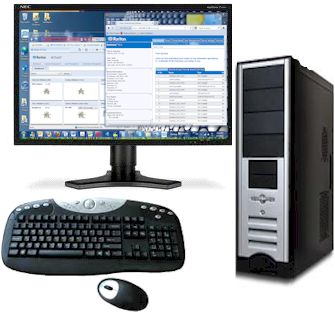Once you have created the dual video port group, it is available on the Port Access page. Two KVM channels are required to remotely connect to the dual video port group by clicking primary port. If two channels are not available, the Connect link is not displayed.
Session timeouts that are configured on the CommandCenter Secure Gateway are applied to both ports of a dual video group.
Once the windows are displayed, they can be moved based on the display setup you are using. For example, if you are using extended desktop mode, the port windows can be moved between monitors.

Set the target server’s primary and secondary displays to the same video resolution in order to maintain mouse synchronization and minimize having to periodically resync.
Depending on the desired orientation, the top display (vertical orientation) or left display (horizontal orientation) should be the designated primary display. This display will provide active menu selection for virtual media, audio, smart card and mouse operations.
In order to provide intuitive mouse movement and control, the following should have the same display orientation: the client PC’s primary and secondary displays, the KX II’s dual video port group configuration, and target server’s primary and secondary displays.
Only the following Client Launch Settings will be applied to dual port video displays:
The use of single mouse mode is not recommended when displaying dual video ports in full screen mode on a single client monitor. This will require exiting single mouse mode in order to access and view the other display.
Target operating systems |
Supported mouse modes |
Comments |
|---|---|---|
All Windows® operating systems |
Intelligent, Standard and Single Mouse Modes |
If ‘Strech’ mode is supported by the target server video card, Absolute mouse mode will operate correctly. Stretch mode is where the target server manages the dual display as a single contiguous virtual display. In contrast the target server will consider the displays as two independent displays when configured in Extended mode. For Extended mode, intelligent mouse mode is recommended. |
Linux® |
Intelligent and Standard Mouse Modes |
Linux® VKC/MPC users may experience display and mouse movement issues using single mouse mode. Raritan recommends Linux users do not use single mouse mode. |
Mac® operating system |
Single Mouse Mode |
Mouse does not synch on Mac dual video port targets. |